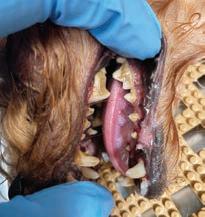
2 minute read
You’ve Heard This Before?
Offered by: John Wilson, B.S., BC-HIS - Blue Ribbon Hearing & Tinnitus Center

Advertisement

For many years, one of my favorite sayings has been, “Repetition is a law of learning” or as a doctor friend of mine told me “Repetition is the language of the brain.” Even though I know this, I sometimes question whether I should repeat article topics. Based on a number of recent experiences, here are a few things that need to be repeated.
First, “Don’t stick anything in your ear smaller than your elbow.” Cotton swabs (Q-tips) often do more harm than good when put in the ear canal.
e damage I have seen from bobby pins, cotton swabs, crochet hooks and pencils going through an eardrum is unforgettable. Most people don’t realize the distance from the opening of the ear canal to the eardrum is less than half the length of a Q-tip. Pushing a cotton swab into the ear canal can not only impact wax, it can also cause a ruptured eardrum, potentially leading to permanent conductive hearing loss. If you must use a cotton swab, just use it to wipe out the outer most part of the canal where wax naturally drains, and around the grooves and channels of the outer ear. Multiple people this week who came in with sudden onset hearing loss told me they used Q-tips, but didn’t “go in that deep,” and yet each one of them had wax impacted all the way to the eardrum.
Second, be cautious of putting any liquid or solution in the ear canal. e chemicals often recommended for ear cleaning, whether it be hydrogen peroxide or an over-the-counter solution such as Debrox (carbamide peroxide), promise to help remove wax and restore hearing. While these products can be good at softening and breaking down wax, they are not good a breaking down or removing layers of sloughed dead skin, foreign objects or debris. ey can also damage otherwise healthy tissue. Liquid or moisture trapped between dead skin and living tissue can encourage bacterial or fungal growth. Multiple times in recent weeks, I have looked into an ear canal and found the skin burned by straight hydrogen peroxide. I have seen similar burns from solutions used for too many days or left in the ear too long. Hydrogen peroxide should be diluted with at least 50% clean, warm water before being put in the ear. Carbamide peroxide should be used according to instructions and is best when rinsed out.
Next, knowing what is happening inside the canal is also critical to proper care. Every time someone asks me what to put in ears to clean them, I respond, “Nothing until I look in the ear canal.” Last week I witnessed the worst-case scenario for someone putting solution in an ear without looking inside first. e patient described not being able to hear and decided it must be wax, so they put Debrox in the canal. e patient reported immediately experiencing extreme pain and the hearing got worse. When I looked in the canal, I saw a hole in the eardrum and severely damaged tissue in and around the eardrum along with drainage from the hole. ere was severe trauma and infection after the solution went through the eardrum into the middle ear. ey were referred to an ENT for medical treatment. In this case, seeing a professional BEFORE using liquid would have prevented some serious pain and damage.
Finally, treating hearing loss sooner than later is the best way to ensure hearing health later in life. Wearing hearing aids when needed decreases brain shrinkage, cognitive decline and the probability of dementia. Quality of life is better as speech understanding, hearing in noise, and general understanding is better for those who treat hearing loss sooner. Overall health is better for those who treat hearing loss and maintain an active social life.















